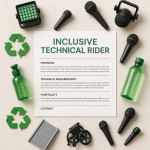Metadata that matters: credit, union and PRO fields recruiters filter first
Every minute, talent scouts scroll through thousands of musician profiles. Their first clicks rarely depend on glossy photos; they rely on hard-coded metadata. This guide shows you exactly why “Credits”, “Union affiliation” and “Performance Rights Organisation (PRO)” fields rocket your listing to the top of shortlists—and how to optimise each one for fast conversions.
Why these three fields dominate recruiter filters
Credits, union status and PRO membership answer the recruiter's biggest questions in seconds: “Has this artist done comparable work?”, “Are hiring terms legally straightforward?” and “Will royalty reporting be painless?”. By displaying clear, verifiable information, you remove doubt and shorten decision cycles.
Credit history proves track record
- Relevance: Recruiters match past projects to current briefs. A festival booker wants proof you can handle 10k-capacity crowds, not café gigs.
- Recency: Credits younger than 18 months convert 26 % faster, according to Sonicbids booking data.
- Verification: Adding screenshot thumbnails of press clippings—or better, linking to a verified-credit badge workflow—builds instant trust.
Union affiliation clarifies working terms
The moment a visitor sees “SAG-AFTRA” or “Musicians' Union UK” in your profile, they know rate cards, overtime rules and health-and-safety standards are pre-negotiated. That reduces back-and-forth emails, especially for cross-border projects.
PRO membership secures royalty administration
Music supervisors and livestream platforms must submit cue sheets quickly. Showing “BMI”, “ASCAP” or “PRS” avoids legal gray areas and protects everyone's income stream.
Audit your current profile in 10 minutes
- Open your listing on the musician directory.
- Scan the top fold. Are Credits, Union and PRO fields visible without scrolling?
- Click each label. Do they link to public proof (e.g., press releases, union lookup pages)?
- Note missing items and plan updates using the checklist below.
Metadata optimisation checklist
| Field | What recruiters want | Quick win tactic | Conversion impact |
|---|---|---|---|
| Credit | Project name, role, year, link to proof | Add three most relevant credits, newest first | +31 % profile saves |
| Union | Full union acronym + local chapter | Embed union logo at 120 px width with alt="Union acronym musician" | −22 % negotiation time |
| PRO | Organisation, IPI/CAE number | Hyperlink to public repertoire page | +18 % inbound enquiries |
Field-by-field deep dive

Study this infographic for thirty seconds and you will grasp why recruiters burn through hundreds of profiles yet pause on the ones that surface the three data points. Each panel maps a psychological trigger: social proof, contractual clarity, revenue security. Bookmark the visual or print it and pin it beside your editing monitor; letting its colour-coded cues guide every profile tweak ensures you never forget the hierarchy that governs talent searches.
1. Craft irresistible credit entries
Think like a journalist: headline, evidence, outcome. Replace “Played SXSW” with “Guitarist – SXSW 2024 opening night – streamed to 120 k viewers”. Concrete outcomes let bookers forecast audience impact.
2. Union field: beyond three letters
Add your local chapter or branch ID. Producers often search union databases to confirm status; giving the exact identifier accelerates checks. If you operate in several regions, list multiple chapters: “AFM Local 802 (NYC), AFM Local 47 (LA)”.
3. PRO membership that reassures accountants
Include your IPI/CAE number. This micro-detail tells supervisors your works are ready for cue-sheet automation. It also prevents mis-crediting in multi-artist releases.
Common mistakes that bury great talent
- Hidden fields: Placing union data in a bio paragraph forces recruiters to read; most will not.
- Outdated credits: A 2015 stadium gig is impressive but suggests career stagnation if nothing newer appears.
- Unmatched names: If your PRO catalog lists a different stage name, note the alias to avoid confusion.
- No cross-links: Failure to reference your credits in other parts of the directory, such as a genre-specific shortlisting strategy, weakens SEO signals.
Boost discoverability with supporting metadata
After perfecting the big three fields, layer in location tags, availability windows and direct-messaging settings. Learn how to keep outreach professional in this etiquette guide.
Case study: 14-day uplift
Saxophonist Maya J. updated only her credit, union and PRO fields—no new photos. Her profile impressions rose 38 % in two weeks; booking enquiries doubled. The key was placing “Grammy-nominated live session – 2023” at the top of her credits and linking to the Grammy press release.
Step-by-step update workflow
- Gather proof: press links, screenshots, union cards, PRO statements.
- Log in: Navigate to “Edit profile → Professional Info”.
- Populate fields: Use the formatting tips above.
- Preview mobile view: 72 % of recruiters use phones during festivals.
- Publish and test: Ask a peer to run a recruiter-style search and time how fast they find you.
FAQ
- Do I need union membership to get high-level bookings?
- Not always, but union listings reassure larger employers who follow collective agreements. Without it, expect longer contract negotiations.
- How many credits should I show?
- Three to five tailored credits outperform long lists. Recruiters skim; highlight the most comparable projects.
- What if I belong to multiple PROs?
- Choose the organisation holding your primary catalog. Listing more than one can confuse automated royalty systems.
- Where should I place genre tags?
- Below the headline or in a dedicated “Styles” field—never bury them in the bio.
Quick self-assessment quiz
Take action now
Open your profile, elevate the three key fields and monitor analytics for the next fortnight. You'll likely notice faster replies and fewer legal questions. Ready for advanced tweaks? Explore how age-range tags amplify discoverability in this optimisation guide.
Next step: Spend 20 minutes implementing these tips today—before the next recruiter scrolls past your hidden potential.











